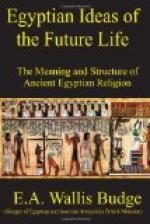Now, it is easy to see from the above description of the torments which the wicked were supposed to suffer, that the writer had in his mind some of the pictures with which we are now familiar, thanks to the excavation of tombs which has gone on in Egypt during the last few years; and it is also easy to see that he, in common with many other Coptic writers, misunderstood the purport of them. The outer darkness, i.e., the blackest place of all in the underworld, the river of fire, the pits of fire, the snake and the scorpion, and such like things, all have their counterparts, or rather originals, in the scenes which accompany the texts which describe the passage of the sun through the underworld during the hours of the night. Having once misunderstood the general meaning of such scenes, it was easy to convert the foes of R[=a], the Sun-god, into the souls of the damned, and to look upon the burning up of such foes—who were after all only certain powers of nature personified—as the well-merited punishment of those who had done evil upon the earth. How far the Copts reproduced unconsciously the views which had been held by their ancestors for thousands of years cannot be said, but even after much allowance has been made for this possibility, there remains still to be explained a large number of beliefs and views which seem to have been the peculiar product of the Egyptian Christian imagination.




